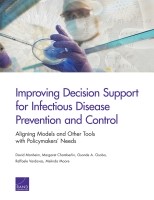| 来源类型 | Research Reports
|
| 规范类型 | 报告
|
| DOI | https://doi.org/10.7249/RR1576
|
| ISBN | 9780833095503
|
| 来源ID | RR-1576-OSD
|
| Improving Decision Support for Infectious Disease Prevention and Control: Aligning Models and Other Tools with Policymakers' Needs |
| David Manheim; Margaret Chamberlin; Osonde A. Osoba; Raffaele Vardavas; Melinda Moore
|
| 发表日期 | 2016
|
| 出版年 | 2016
|
| 页码 | 50
|
| 语种 | 英语
|
| 结论 |
Several Modeling and Nonmodeling Decision-Support Tools Are Available to Inform Infectious Disease Prevention and Control; Policymakers and Modelers Should Understand the Capabilities and Limitations of Each and Select the Best Approach(es) Based on the Circumstances and the Questions to Be Addressed- Theory-based models work well when there is sufficient understanding and information on the disease dynamics and when the models are sufficiently validated in the context considered.
- Theory-based models are best suited to address questions about the magnitude of the threat and where interventions are possible, as well as to compare potential interventions; they are less useful than statistical models for forecasting disease incidence.
- Statistical models can make useful inferences and predictions without requiring a full understanding of all underlying causal mechanisms. But their use comes at a price: higher sensitivity to violations of the invariance assumption and difficulty using them to make decisions informed by causal relationships.
- Statistical models are best suited for mechanistic quantitative predictions concerning the phenomenon of interest (e.g., How fast will it spread? When will it peak?).
- Nonmodeling approaches are typically more valuable for real-time decisions. They can be informed by modeling, which is best undertaken before real-time decisions are needed. Examples include expert elicitation, policy analysis frameworks, preparedness exercises, and intra-action reports.
- A variety of techniques can assist in communication and planning for appropriate use of models and nonmodeling approaches. This starts with better mutual understanding between modelers and policymakers of both the tools available and the questions that policymakers face.
|
| 摘要 |
- Establish partnerships and communications between modelers and policymakers before an emergency arises.
- Coordinate at multiple levels, including with program managers responsible for implementing actions and interventions.
- Ensure the timely availability of data needed for modeling.
- Clarify priority policy questions and ensure that modelers understand them.
- Use relevant nonmodeling approaches to provide decision support.
- Use the most-appropriate models and other approaches to meet specific real-world needs.
- Set appropriate expectations for the use of models.
- Improve models and modeling approaches.
- Improve the modeling ecosystem.
|
| 主题 | Complex Systems Analysis
; Exploratory Modeling
; Infectious Diseases
; Operational Readiness
; Public Health Preparedness
; Robust Decision Making
|
| URL | https://www.rand.org/pubs/research_reports/RR1576.html
|
| 来源智库 | RAND Corporation (United States)
|
| 引用统计 |
|
| 资源类型 | 智库出版物
|
| 条目标识符 | http://119.78.100.153/handle/2XGU8XDN/108195
|
推荐引用方式
GB/T 7714 |
David Manheim,Margaret Chamberlin,Osonde A. Osoba,et al. Improving Decision Support for Infectious Disease Prevention and Control: Aligning Models and Other Tools with Policymakers' Needs. 2016.
|
|
文件名:
|
x1495299404315.jpg
|
|
格式:
|
JPEG
|

|
文件名:
|
RAND_RR1576.pdf
|
|
格式:
|
Adobe PDF
|
除非特别说明,本系统中所有内容都受版权保护,并保留所有权利。